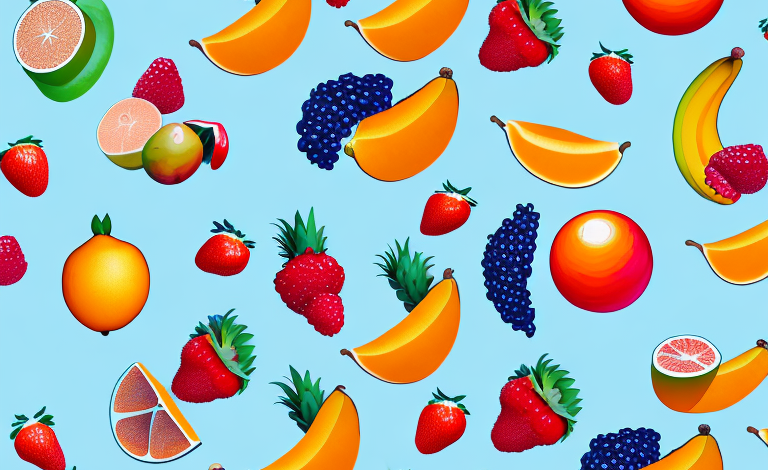Fruits are an essential part of a healthy diet, and there are various ways to consume them. Blending fruits has become a popular trend in recent times due to the convenience it offers. However, there has been a debate over whether blending fruits is better than eating them whole. In this article, we will explore the science behind blending fruits and its benefits, compare the benefits of eating whole fruits, and understand how blending fruits affects their nutritional value.
The science behind blending fruits and its benefits
Blending is a process that breaks down the fibers of fruits, making it easier for the body to extract the nutrients. The blending process helps to unlock the nutrients that may not be available when the fruits are consumed whole. Additionally, blended fruits are easily digestible and can help the body absorb nutrients better due to the pre-digestion that takes place during blending.
Blended fruits also offer a more convenient option to consumers, as it can be consumed on the go, at work, or after a workout. Blending fruits also offers a way to consume a variety of fruits in one serving, which can be beneficial for individuals who may not have the time to consume multiple fruits throughout the day.
Furthermore, blending fruits can also help to reduce food waste. Often, when fruits are overripe or bruised, they may not be appealing to eat whole. However, by blending them, these fruits can still be used and their nutrients can be extracted. This can be a great way to reduce food waste and make use of fruits that may have otherwise been thrown away.
Benefits of eating whole fruits instead of blending them
While blending fruits may offer some benefits, eating whole fruits is also essential for maintaining a healthy diet. Whole fruits contain more fiber, which is important for maintaining healthy digestion and can also help keep you full for longer periods. Additionally, consuming fruits in their whole form can help improve dental health, as chewing helps to produce saliva, which neutralizes the acid in the mouth and cleanses the teeth.
Eating whole fruits also offers a more satisfying experience, as chewing and savoring the different flavors and textures can stimulate the senses and provide a more enjoyable eating experience.
Another benefit of eating whole fruits is that they contain more nutrients than blended fruits. When fruits are blended, they are exposed to air and heat, which can cause some of the nutrients to break down. Eating whole fruits ensures that you are getting the full range of vitamins, minerals, and antioxidants that they offer.
Furthermore, eating whole fruits can help regulate blood sugar levels. When fruits are blended, their natural sugars are released more quickly into the bloodstream, which can cause a spike in blood sugar levels. Eating whole fruits, on the other hand, allows the body to digest the sugars more slowly, which can help prevent blood sugar spikes and crashes.
Pros and cons of blending fruits for a healthy diet
When considering blending fruits for a healthy diet, there are both pros and cons to consider. The pros of blending fruits include the convenience, ability to consume multiple types of fruits in one serving, and the ease of digestion. However, the cons of blending fruits include the potential for added sugars and a decrease in fiber content.
When blended, the sugars in the fruits can become concentrated, which can lead to a higher sugar intake. Additionally, blending fruits can cause the fiber content to decrease, leading to a less filling and less satisfying meal or snack. It is, therefore, important to consider the overall nutritional value of blended fruits before making them a regular part of your diet.
Another potential con of blending fruits is the loss of nutrients due to oxidation. When fruits are blended, they are exposed to air, which can cause the nutrients to break down and lose their potency. To minimize this, it is recommended to consume blended fruits immediately after preparation or store them in an airtight container in the refrigerator for no more than 24 hours.
On the other hand, blending fruits can also provide a convenient way to incorporate more nutrients into your diet. By adding leafy greens, nuts, and seeds to your fruit blends, you can increase the fiber, protein, and healthy fat content of your meal or snack. This can help you feel fuller for longer and provide sustained energy throughout the day.
How blending fruits affects the nutritional value of the fruit
Blending fruits can affect the nutritional value of the fruit in several ways. As mentioned earlier, blending can cause the fiber content to decrease, leading to less-filling meals. Blending can also lead to the loss of some important nutrients, such as vitamin C, which is sensitive to heat and air.
However, blending can also help to unlock some of the nutrients that may not be available when the fruits are consumed whole. For example, blending breaks down the cell walls of the fruits, making nutrients more accessible to the body. Additionally, blending can help to extract important phytochemicals that may not be accessible when consuming whole fruits.
Understanding the process of digestion for blended fruit versus whole fruit
The process of digestion for blended fruit versus whole fruit varies due to the way the fruits are consumed. The blending process pre-digests the fruits, breaking down the fibers and cell walls that make the nutrients more accessible to the body. This also causes the sugars in the fruits to become more concentrated, leading to a quicker release of energy.
Eating whole fruits, however, requires the body to work harder to extract the nutrients. Digestion of whole fruits takes longer, and the fibers in the fruits help slow the release of energy, which can help sustain energy levels for a longer period. Additionally, chewing whole fruits helps to stimulate the release of enzymes that help the body digest the fruits more efficiently.
Exploring the different types of blenders and their impact on fruit nutrition
When it comes to blending fruits, there are several types of blenders available on the market. These blenders vary in size, shape, and power, and each can have a different impact on the nutritional value of the fruit.
High-powered blenders, such as Vitamix or Blendtec, are capable of breaking down the fibers of the fruits to a greater extent, making the nutrients more accessible to the body. However, less powerful blenders may not break down the fibers as well, leading to a less smooth consistency and fewer nutrients being available to the body.
Tips for maximizing the nutritional benefits of blended fruits in your diet
While there are some cons to blending fruits, there are ways to maximize the nutritional benefits of blended fruits in your diet. Firstly, it is important to choose fresh fruits and vegetables to ensure that they are packed with the necessary nutrients. Additionally, it is essential to consume blended fruits in moderation to avoid excessive sugar intake.
Adding greens, such as spinach or kale, to blended fruits can also help increase the nutritional content and fiber content of the drink. Finally, using low-fat milk, yogurt, or nut milk can help reduce the sugar content of the drink further.
The impact of fiber on blended fruit nutrition
Fiber is an essential part of any diet and is particularly important when it comes to blended fruits. As mentioned earlier, blending fruits can decrease the fiber content of the drink, leading to a less filling and less satisfying meal or snack.
However, adding fiber-rich ingredients such as oats, chia seeds, or nuts can help increase the fiber content of the drink and make it more filling. Additionally, consuming blended fruits with a meal that has a higher fiber content can help increase overall fiber intake.
The role of antioxidants in blended versus whole fruit consumption
Antioxidants are important nutrients that help protect the body from damage caused by free radicals. Many fruits are rich in antioxidants, and both blended and whole fruits can offer these benefits.
There have been debates over whether blended or whole fruits offer more antioxidants. However, research indicates that both forms of consumption offer similar antioxidant benefits. Blended fruits may offer more benefits in terms of bioavailability, as blending can make antioxidants more accessible to the body.
Common myths about blending fruits and their debunking
There are several myths surrounding blending fruits that can cause confusion and misinformation. One common myth is that blending destroys enzymes, causing a loss of nutrients. However, enzymes are readily available in fresh fruits and are not destroyed during blending.
Another common myth is that blending causes harm to teeth due to acidic content. However, a study conducted by the Journal of Clinical Dentistry showed that blending does not cause enamel erosion as long as individuals rinse their mouths with water afterward.
Comparison between fresh and packaged blended fruit options
When it comes to blended fruits, there are many options available on the market, including fresh and packaged options. While fresh blended fruits offer the benefits of using fresh ingredients, packaged blended fruit options offer a convenient alternative for individuals who do not have the time to prepare their own fruit blends.
However, it is important to consider the added sugars and preservatives in packaged blended fruit drinks. Some packaged blended fruit options may contain high amounts of added sugars, which can negate the health benefits of consuming blended fruits.
The impact of added sugars in blended fruit drinks
As mentioned earlier, added sugars can be a significant concern when it comes to blended fruit drinks. Some packaged blended fruit options may contain high amounts of added sugars, which can lead to an increase in overall sugar intake.
To avoid excessive sugar intake, it is essential to read the labels of packaged blended fruit options and opt for those with lower amounts of added sugars. Additionally, individuals can make their own blended fruit drinks at home, using fresh ingredients and natural sweeteners like honey or maple syrup.
Understanding portion sizes when consuming blended fruit
Another important consideration when consuming blended fruits is portion size. While blended fruits can offer numerous nutritional benefits, excessive consumption can lead to an increase in overall calorie and sugar intake.
It is therefore important to consider the recommended portion sizes for blended fruit drinks and to consume them in moderation. Additionally, consuming blended fruits as part of a meal or snack that includes other nutrient-dense foods can help ensure a well-balanced diet.
How to incorporate blended fruits into your daily diet plan
Blended fruits can make an excellent addition to any diet plan. As mentioned earlier, they offer convenience, versatility and can provide a variety of important nutrients. When incorporating blended fruits into your daily diet plan, it is essential to consider overall calorie and sugar intake and to balance blended fruit consumption with other nutrient-dense food groups.
It is also important to experiment with various fruit combinations and to consider adding other nutrient-dense ingredients like greens, nuts, or seeds to boost overall nutritional value. Additionally, individuals can consider replacing high-sugar, high-fat snacks with blended fruit drinks to help promote overall health and well-being.
Conclusion
When it comes to blended fruits versus eating them whole, there is no easy answer. Both forms of consumption offer their unique benefits and drawbacks. Blending fruits can offer convenience, ease of digestion, and accessibility to important nutrients. However, eating whole fruits can provide more fiber, dental health benefits, and a more satisfying eating experience.
Ultimately, the choice between blended fruits and whole fruits depends on individual preferences and nutritional needs. By considering the overall nutritional value of blended fruits, portion sizes, and ingredients, individuals can make an informed decision about incorporating blended fruits into their diet plan.



